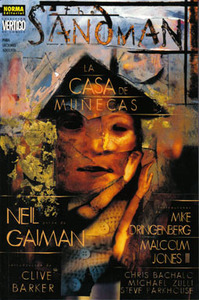You need to sign in or sign up before continuing.
Take a photo of a barcode or cover
Again, Gaiman delivers! This volume seems a little more locked down, in terms of his writing style and the flow of issue from one to another.
One my favorite parts about Sandman, as a comics collection so far, is the variety of writing styles and genres that are included from issue to issue. This requires some familiarity, but it's been wonderful. Again, I can't wait to come back to this one as well to unearth some more gems of understanding!
One my favorite parts about Sandman, as a comics collection so far, is the variety of writing styles and genres that are included from issue to issue. This requires some familiarity, but it's been wonderful. Again, I can't wait to come back to this one as well to unearth some more gems of understanding!
adventurous
dark
mysterious
tense
medium-paced
dark
mysterious
sad
fast-paced
Plot or Character Driven:
A mix
Strong character development:
No
Loveable characters:
Complicated
Diverse cast of characters:
Yes
Flaws of characters a main focus:
Complicated
dark
emotional
mysterious
medium-paced
Plot or Character Driven:
A mix
Strong character development:
Yes
Loveable characters:
Complicated
Diverse cast of characters:
Yes
challenging
dark
emotional
tense
fast-paced
7.6.22
dark
mysterious
fast-paced
Plot or Character Driven:
A mix
dark
emotional
tense
fast-paced
Plot or Character Driven:
A mix
Strong character development:
No
Loveable characters:
Complicated
Diverse cast of characters:
Yes
Flaws of characters a main focus:
Yes
(4.5 out of 5 stars)
For me, The Doll's House is where The Sandman first starts feeling like the series it'll become known for being. A lot of seeds are sown for later arcs - Rose, Barbie, Desire's beef with Dream, etc - and a lot of the series' rules are first codified in these issues. But it also maintains some of the problems found in the series' first arc as well and also manages to rank among the arcs that have aged the least well.
The Doll's House has a much stronger story than Preludes & Nocturnes. It's a story about Rose Walker and her family, continuing to tie up story threads left dangling from the previous arc. While everything takes a bit of time to get moving - the arc starts with one of those one-shots The Sandman is famous for having, which ends up being a muse on the very act of storytelling, a central theme of the series - once the story gets going, it never really stops. We're taken from England to Florida to Georgia (and a serial killer's convention) all the way back to the Dreaming as Rose Walker tries to unravel the threads of her family history.
I still find the narrative to be a pretty good one, but there are elements of it that haven't aged well. For a start, Desire is frequently referred to by the "it" pronoun. I understand that it was the early 90s when this was published and the singular "they/them/their" pronoun wasn't as widely used as it is today, but hearing an explicitly androgynous character like Desire referred to as an "it" hits in an unfortunate way. I don't think there was any mal intent on Gaiman's part, but it's something that hasn't aged well. The same is true for some of the scenes depicted in the serial killer's convention plot. To be fair, Gaiman never comes close to sympathizing with these killers, but some of those scenes are so disturbing that it's almost not fun to read them. Perhaps that's the point, but I think it'll be hard for some modern readers to fully get behind that.
Still, there's a lot to love in The Doll's House, though, including its artwork. This time, the bulk of the issues are illustrated by Mike Dringenberg, giving more of the artwork a kind of uniformity that I felt was missing in the first arc. A few of the issues are illustrated by other artists - Chris Bachalo tackles issue #12 while Michael Zulli illustrates issue #13 - but both of these issues act more as side plots of the main story and so their differing art style feels intentional and appropriate. Dringenberg's art style is still not my favorite, but it certainly does the job. There are some beautiful images in this book - often a mixture of reality and surreality - but they are deftly balanced with the kind of artwork needed to ensure the story is visually understandable.
At the end of the day, The Doll's House inches The Sandman closer to what the series is known for. It features a main storyline that, while featuring some elements that haven't aged well, remains devilishly interesting and captivating to read. It's impressive seeing just how much of the series' overarching storyline is seeded in these early arcs and it's clear, even from this early on, how well Gaiman understands the world and the characters he's created. I think that if readers can make it to this arc, they'll be hooked into the world of The Sandman.
For me, The Doll's House is where The Sandman first starts feeling like the series it'll become known for being. A lot of seeds are sown for later arcs - Rose, Barbie, Desire's beef with Dream, etc - and a lot of the series' rules are first codified in these issues. But it also maintains some of the problems found in the series' first arc as well and also manages to rank among the arcs that have aged the least well.
The Doll's House has a much stronger story than Preludes & Nocturnes. It's a story about Rose Walker and her family, continuing to tie up story threads left dangling from the previous arc. While everything takes a bit of time to get moving - the arc starts with one of those one-shots The Sandman is famous for having, which ends up being a muse on the very act of storytelling, a central theme of the series - once the story gets going, it never really stops. We're taken from England to Florida to Georgia (and a serial killer's convention) all the way back to the Dreaming as Rose Walker tries to unravel the threads of her family history.
I still find the narrative to be a pretty good one, but there are elements of it that haven't aged well. For a start, Desire is frequently referred to by the "it" pronoun. I understand that it was the early 90s when this was published and the singular "they/them/their" pronoun wasn't as widely used as it is today, but hearing an explicitly androgynous character like Desire referred to as an "it" hits in an unfortunate way. I don't think there was any mal intent on Gaiman's part, but it's something that hasn't aged well. The same is true for some of the scenes depicted in the serial killer's convention plot. To be fair, Gaiman never comes close to sympathizing with these killers, but some of those scenes are so disturbing that it's almost not fun to read them. Perhaps that's the point, but I think it'll be hard for some modern readers to fully get behind that.
Still, there's a lot to love in The Doll's House, though, including its artwork. This time, the bulk of the issues are illustrated by Mike Dringenberg, giving more of the artwork a kind of uniformity that I felt was missing in the first arc. A few of the issues are illustrated by other artists - Chris Bachalo tackles issue #12 while Michael Zulli illustrates issue #13 - but both of these issues act more as side plots of the main story and so their differing art style feels intentional and appropriate. Dringenberg's art style is still not my favorite, but it certainly does the job. There are some beautiful images in this book - often a mixture of reality and surreality - but they are deftly balanced with the kind of artwork needed to ensure the story is visually understandable.
At the end of the day, The Doll's House inches The Sandman closer to what the series is known for. It features a main storyline that, while featuring some elements that haven't aged well, remains devilishly interesting and captivating to read. It's impressive seeing just how much of the series' overarching storyline is seeded in these early arcs and it's clear, even from this early on, how well Gaiman understands the world and the characters he's created. I think that if readers can make it to this arc, they'll be hooked into the world of The Sandman.







